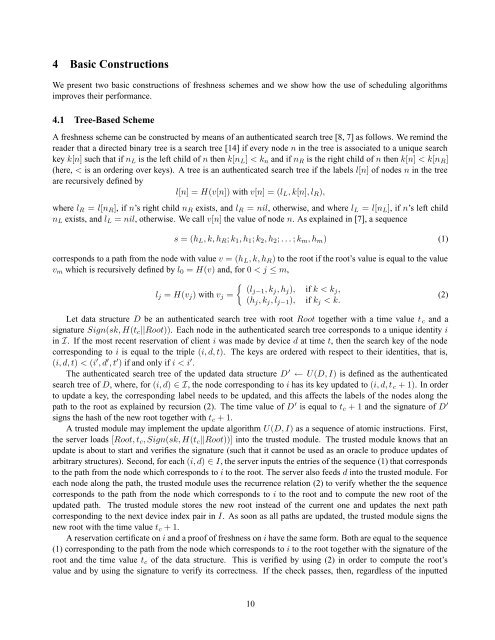Proof of Freshness - Computation Structures Group - MIT
Proof of Freshness - Computation Structures Group - MIT
Proof of Freshness - Computation Structures Group - MIT
Create successful ePaper yourself
Turn your PDF publications into a flip-book with our unique Google optimized e-Paper software.
4 Basic Constructions<br />
We present two basic constructions <strong>of</strong> freshness schemes and we show how the use <strong>of</strong> scheduling algorithms<br />
improves their performance.<br />
4.1 Tree-Based Scheme<br />
A freshness scheme can be constructed by means <strong>of</strong> an authenticated search tree [8, 7] as follows. We remind the<br />
reader that a directed binary tree is a search tree [14] if every node n in the tree is associated to a unique search<br />
key k[n] such that if nL is the left child <strong>of</strong> n then k[nL] < kn and if nR is the right child <strong>of</strong> n then k[n] < k[nR]<br />
(here, < is an ordering over keys). A tree is an authenticated search tree if the labels l[n] <strong>of</strong> nodes n in the tree<br />
are recursively defined by<br />
l[n] = H(v[n]) with v[n] = (lL, k[n], lR),<br />
where lR = l[nR], if n’s right child nR exists, and lR = nil, otherwise, and where lL = l[nL], if n’s left child<br />
nL exists, and lL = nil, otherwise. We call v[n] the value <strong>of</strong> node n. As explained in [7], a sequence<br />
s = (hL, k, hR; k1, h1; k2, h2; . . . ; km, hm) (1)<br />
corresponds to a path from the node with value v = (hL, k, hR) to the root if the root’s value is equal to the value<br />
vm which is recursively defined by l0 = H(v) and, for 0 < j ≤ m,<br />
lj = H(vj) with vj =<br />
(lj−1, kj, hj), if k < kj,<br />
(hj, kj, lj−1), if kj < k.<br />
Let data structure D be an authenticated search tree with root Root together with a time value tc and a<br />
signature Sign(sk, H(tc||Root)). Each node in the authenticated search tree corresponds to a unique identity i<br />
in I. If the most recent reservation <strong>of</strong> client i was made by device d at time t, then the search key <strong>of</strong> the node<br />
corresponding to i is equal to the triple (i, d, t). The keys are ordered with respect to their identities, that is,<br />
(i, d, t) < (i ′ , d ′ , t ′ ) if and only if i < i ′ .<br />
The authenticated search tree <strong>of</strong> the updated data structure D ′ ← U(D, I) is defined as the authenticated<br />
search tree <strong>of</strong> D, where, for (i, d) ∈ I, the node corresponding to i has its key updated to (i, d, tc + 1). In order<br />
to update a key, the corresponding label needs to be updated, and this affects the labels <strong>of</strong> the nodes along the<br />
path to the root as explained by recursion (2). The time value <strong>of</strong> D ′ is equal to tc + 1 and the signature <strong>of</strong> D ′<br />
signs the hash <strong>of</strong> the new root together with tc + 1.<br />
A trusted module may implement the update algorithm U(D, I) as a sequence <strong>of</strong> atomic instructions. First,<br />
the server loads [Root, tc, Sign(sk, H(tc||Root))] into the trusted module. The trusted module knows that an<br />
update is about to start and verifies the signature (such that it cannot be used as an oracle to produce updates <strong>of</strong><br />
arbitrary structures). Second, for each (i, d) ∈ I, the server inputs the entries <strong>of</strong> the sequence (1) that corresponds<br />
to the path from the node which corresponds to i to the root. The server also feeds d into the trusted module. For<br />
each node along the path, the trusted module uses the recurrence relation (2) to verify whether the the sequence<br />
corresponds to the path from the node which corresponds to i to the root and to compute the new root <strong>of</strong> the<br />
updated path. The trusted module stores the new root instead <strong>of</strong> the current one and updates the next path<br />
corresponding to the next device index pair in I. As soon as all paths are updated, the trusted module signs the<br />
new root with the time value tc + 1.<br />
A reservation certificate on i and a pro<strong>of</strong> <strong>of</strong> freshness on i have the same form. Both are equal to the sequence<br />
(1) corresponding to the path from the node which corresponds to i to the root together with the signature <strong>of</strong> the<br />
root and the time value tc <strong>of</strong> the data structure. This is verified by using (2) in order to compute the root’s<br />
value and by using the signature to verify its correctness. If the check passes, then, regardless <strong>of</strong> the inputted<br />
10<br />
(2)
















